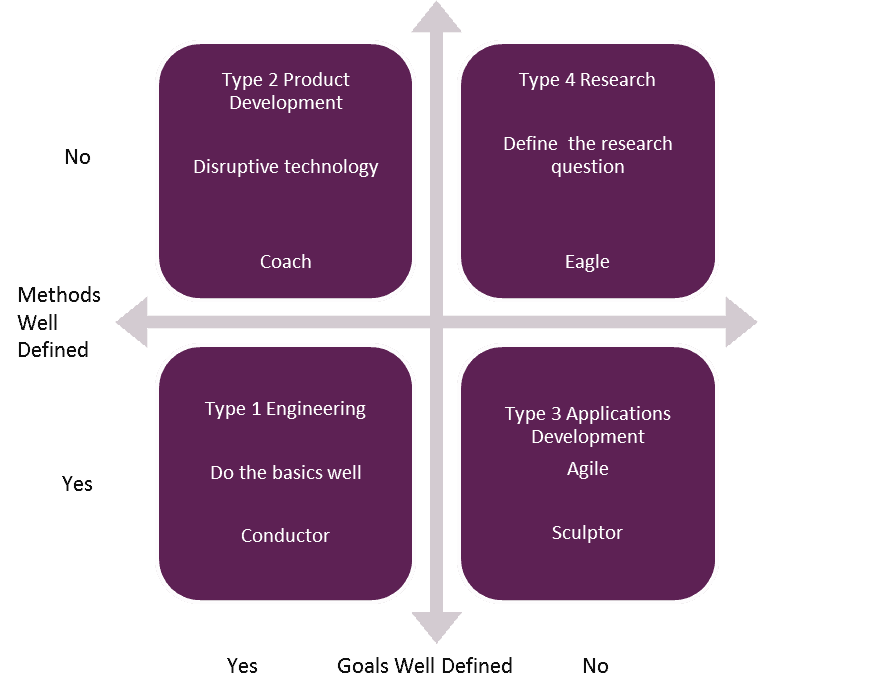Sometimes it’s interesting how new ideas are generated by our brains, most of the time we are comfortable in our world and then events conspire to push us in a new direction. The past seven days, for me has been one to these periods. The first was the APM conference on new frontiers. The presentation by the two key note speakers (Camila Batmanghelidjh and Eddie Obeng) both talked about flexibility and adaptability in a world in which the pace of change is ever increasing. The second was delivering a course with an IT Director at a Global Charity. This integrates agile and waterfall project management into a common approach and the third was preparing for a meeting with one of the most innovative companies in the UK to talk about the application of project management in the product development environment. All this lead me back to Turner and Cochrane’s goal method matrix developed in 1993, before the birth of agile in 2001. How could this be updated for today’s project management.
Four Different Types of Project
Turner and Cochrane identified four different types of project.
Type 1 Earth projects; have clearly defined goals and methods. These are typical construction or engineering projects, where the aim is to deliver the project in the most cost effective and timely manner. Turner and Cochrane talks about the project manager acts as a conductor applying bottom up planning techniques. A modern demonstration of this approach is the London 2012 Olympics where the team concentrated on “doing the basics well”
Type 2 Water projects; have clearly defined goals but poorly defined methods of delivery. These are typical product development projects where the goals are well defined but the methods of delivering those goals are not yet known. Turner and Cochrane’s talk about this type of project needing a multi-skilled team who can explore new avenues for implementation, led by a coach. Today we talk about disruptive technologies; which transform existing functionally of a product or transforms a business model, examples include the smart phone revolution or he streaming on-demand content such a music, sport or even project management training.
Type 3 Fire projects; with poorly defined goals but clear delivery method. Typical these are software application development projects. The technology to deliver the application is well understood, we just don’t know what the users want. Turner and Cochrane’s talk about defining the mission, requirement and the critical role of the sponsor in defining the direction. They see the project manager as a sculptor carving out the image from a solid block. Today we apply agile to this type of project, build a model and let the users see what they will get (before you start to carve the marble), then modify it based on feedback.
Type 4 Blue Sky Projects; with poorly defined goals and methods. Typically these are research of cultural change projects, in which we are exploring an area because it is interesting not with any clearly defined intended purpose or objective. Turner and Cochrane’s talk about the need for creativity and inspirational leadership of these projects, however most project of this form start by defining the research question to be answered. For example how could this organisation give higher levels of customer satisfaction or what new materials can be developed using nano-technology.
Figure 1 Goal Method Matrix Updated for 2014
Reflecting on Turner and Cochrane in 1993 for the perspective of 2014 we can see that the different approaches to project management have matured significantly. The bodies of knowledge for engineering projects are now well defined and codified in the bodies of knowledge, agile approaches to applications development have become common place and most product development pipelines now follow a stage gate approach. However these different world views of project management often don’t see eye to eye, with traditional practitioners declaring that Agile will never work and visa versa. Turner and Cochrane remind us that not all projects are the same and we need to adapt our approach to the projects we manage.
In fact some projects have different types in the same project. The APM conference also heard from Andy Griffee, with is the programme director for the BBC new broadcasting house. In this project I can see at least three different types of project, so maybe that is why it is a programme.

